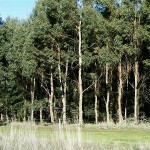
Chances are you’ve never heard of digital deforestation. It’s a relatively new way to look at the environmental impact caused by the switch from printed material to digital forms of communication. Things like email, online magazines, newspapers, and even paperless billing have an environmental impact all their own.
Digital technology uses a tremendous amount of resources. All our data has to be stored somewhere. The digital “cloud” is, in reality, a large data center somewhere. Most likely, it’s a series of server farms in multiple locations.
The largest server farm is 1.1 million square feet in size -- as large as 20 football fields.
Large data centers require vast resources to operate. They consume resources when built and convert huge tracts of water-absorbing land into expanses of concrete and pavement. The accompanying cellular towers that carry all this cloud technology are dotting the landscape with ever increasing frequency. These claim their own share of land and environmental resources. And at the tail end of the technology life cycle are ever-growing mountains of discarded computer equipment piling up in landfills, posing risks to wildlife and ground water.
As of 2014, there were over 250,000 cell towers located in the U.S.
As it turns out, paperless communication isn’t as green as once thought. And printing on paper isn’t necessarily as bad as we’ve been made to believe. In fact, printing – is actually a sustainable business practice that can make good environmental sense.
Paper is good. Paper is made from trees which benefit the environment in a number of ways. Trees reduce soil erosion. Trees recycle carbon dioxide into oxygen. Trees provide habitat for wildlife. The responsible harvesting of mature trees makes room for new tree growth. Flourishing woodlands are a sign of a healthy ecosystem.
Trees are the ultimate “green” product. And the paper made from trees is recyclable. In fact, paper is one of the easiest materials to recycle and reuse.
Roughly 67% of the paper discarded in 2014 was recycled.
Most trees used for paper production in the U.S. are now grown on sustainable tree farms. Tree farming creates thousands of jobs for Americans and pumps millions of dollars back into our economy. The forest products industry in the U.S. has pushed for industry-wide adoption of sustainable forestry practices that include environmental impact reviews and sustainability certifications.
That push to make the paper industry “greener” has filtered down to commercial consumers of paper products. Most paper suppliers now provide products that that are manufactured using cleaner energy and using more ecologically sound processes than was the case 20 years ago.
Resource conservation is always a good idea and there are times when going paperless makes good sense. However, before opting out of printing altogether, consumers may want to take another look at the environmental impact of their decision. Sometimes, putting ink on paper may be the greener option.
-LG, AlphaGraphics Franklin | February 2016